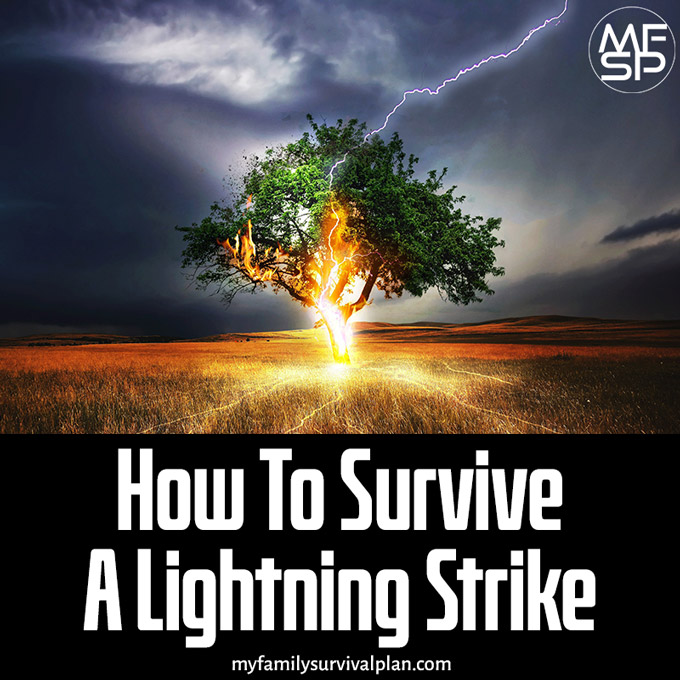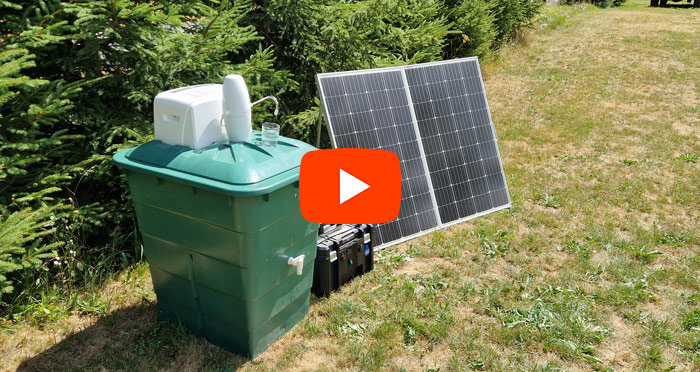Click Here To Join Our Telegram Channel for FREE daily tutorials!

How To Survive A Lightning Strike. Photo -Pixabay (PD)
From 2003 to 2012, nearly 350 people died from being struck by lightning in the US. [1] Many more are struck by lightning and survive, as only about 10 percent of lightning-strike victims are killed (though many do suffer from serious long-term effects).
Contrary to popular belief, what you do during a lightning strike can make all the difference in the outcome, helping you to survive and potentially suffer only minor injuries.
You might think this will never happen to you, but when you consider that the Earth is struck by more than 100 lightning bolts every second, [2] it doesn’t sound so far-fetched, does it? If you live in the US, you have a surprisingly high 1 in 3,000 chance of being struck by lightning in your lifetime. Knowing what to do if it happens can save your life.
How to Survive a Lightning Strike
The illustration, done by Ted Slampyak for The Art of Manliness, shows you the best position to assume if you’re caught in a storm. In a nutshell, here’s what you should know:
• Don’t lie down: If you lie down, an electrical current passing through the ground from a nearby lightning strike can pass right through your body.
• Crouch low: Crouch low so you’re not the tallest object around, and at the same time keep your feet close together with your heels touching. This will help the electricity to go in one foot and out the other. Crouch as low to the ground as you can.
• Crouch on the balls of your feet: This way, a minimal surface of your body is touching the ground and, if a lightning strike does come through you off the ground, the current will most likely travel up one leg and down the other, missing vital organs like your heart.
• Cover your ears: Placing your hands over your ears can help minimize hearing loss from the forthcoming (loud) thunder boom.
• Beware of hair standing on end or skin tingling: These are signs that a lightning strike is imminent. Get into the crouching position immediately if you feel them (but be aware that lightning may strike without these warnings).
If You Can Make It to Your Car, Go There
Have you ever heard of a Faraday suit or Faraday cage? This is what some electrical linemen wear so they can work on live, high-voltage power lines without being electrocuted.
Named after Michael Faraday, a scientist who invented them in the 1800s, the suit or cage is made of a mesh metal or other conducting material, which allows the electrical current to pass through the conducting material without reaching whatever is inside. It moves the current around you rather than through you.
Your car is actually a Faraday cage, which is why you’re safe inside one if lightning strikes (it’s not actually the rubber wheels that protect you, as often believed, it’s the effect of the Faraday cage).
So, if you can make it to your vehicle, do. If not, you’ll want to crouch low to the ground on the balls of your feet with your heels touching, but avoid lying on the ground, as described above.
You Can Be Struck by Lightning Even If the Sky Is Blue
According to an analysis by the National Weather Service, in many lightning-strike deaths, the victims were either headed to safety, or just steps away from safety, when the fatal strike occurred, [3] so if you think a storm is approaching, don’t wait to seek shelter! Many wait far too long, believing the storm is too far away to be a threat. As reported by National Geographic: [2]
“Most people do not realize that they can be struck by lightning even when the center of a thunderstorm is 10 miles (16 kilometers) away and there are blue skies overhead… If you can hear thunder, you are within 10 miles of a storm—and can be struck by lightning. Seek shelter and avoid situations in which you may be vulnerable.”
Furthermore, lightning is not only a concern during a thunderstorm. It can also strike during other weather events, including:
• Heavy snowstorms
• Hurricanes
• Forest fires
• Volcanic eruptions
Generally speaking, if you know a storm is approaching, don’t risk it. Seek shelter immediately. You can also use the 30-30 rule when deciding if you need to take cover. When you see lightning, begin counting until you hear thunder. If the time is 30 seconds or less, it means the storm is within six miles and you should move to safety immediately. [2] Even after the sun comes out, you should wait at least 30 minutes after the last clap of thunder before heading back outside.
The Worst Places to Go in a Thunderstorm
If you’re caught in a thunderstorm, resist the temptation to hide under a tree. Trees are typically the tallest objects around, making them perfect targets for lightning and one of the worst places to seek shelter. If you’re near one, the lightning can jump over to you and follow your body on its way to the ground. Trees can also explode if struck, potentially sending dangerous pieces of wood flying at you!
Rivaling trees as the worst place to go in a thunderstorm would be going near (or in) any type of water, as water is an efficient conductor of electricity (and if you’re swimming, you’ll also be the tallest object around). You also can’t depend on wooden, vinyl, or metal sheds or structures to protect you unless they’re specifically designed to be lightning-safe (and most are not).
Small shelters common to picnic sites, parks, golf courses, and athletic fields will not typically protect you from lightning because they have no mechanism to conduct the electrical current to the ground (such as plumbing or wiring).
Toward that end, if you’re indoors be aware that if lightning strikes, it can travel through electrical and telephone wires, which is why you should avoid contact with electrical appliances, plumbing (don’t take a shower, do laundry, wash dishes, or even wash your hands), and landline phones (phone use is a leading cause of indoor lightning injuries). [2]
Where Are You Most Likely to Be Struck by Lightning?
Contrary to popular belief, it’s not on the golf course, although it is while you’re engaged in leisure activities. According to a National Weather Service analysis, two-thirds of lightning deaths occur in people enjoying outdoor leisure activities. [3] As you might suspect, the deaths spiked during the summer months of June, July, and August, and on Saturdays and Sundays, when people are most likely to be outdoors. Interestingly, golf didn’t even make the top 10 list of leisure activities associated with the most lightning deaths (it was #12). The top locations revealed by the analysis were:
1. Fishing
2. Camping
3. Boating
4. Soccer
5. Beach
6. Farming or ranching
7. Riding a bike, motorcycle, or ATV
8. Social gathering
9. Yard work
10. Walking to/from home
What to Do If You’re Struck by Lightning
Most lightning strikes are not fatal, but that doesn’t mean they’re without consequence. Lightning can injure your nervous system, leading to brain and nerve injuries. It can also lead to cardiac arrest from the electrical shock (and this is typically the cause of death in fatal lightning strikes). Rarely, serious burns may occur. If you’re near someone who has been struck by lightning and they become unresponsive, it is safe to help them (there is no risk of being electrocuted if you touch them).
After calling for emergency help, administering CPR, or CCR, may keep them alive until help arrives. Aside from cardiac arrest, a lightning strike can lead to short-term symptoms such as muscle soreness, headache, nausea, upset stomach, confusion, mental slowness or fogginess, dizziness, and balance problems. In the longer term, other symptoms may also emerge, some of which may be delayed, including: [4]
Problems coding new information and accessing old information:
• Distractibility
• Headaches
• Difficulty sleeping, sometimes sleeping excessively at first and later only two or three hours at a time
• Difficulty carrying on a conversation
Difficulty multitasking:
• Irritability
• Chronic pain from nerve injury
• Personality changes, self-isolation
• Depression
Slower reaction time:
• Inattentiveness or forgetfulness
• Ringing in your ears, dizziness or balance problems
• Embarrassment because you can’t remember people or your responsibilities
In addition to finding a knowledgeable health care provider to treat and help resolve your physical symptoms, the Lightning Strike and Electric Shock Survivors, International (LSESSI) support group [5] can offer you and your family emotional support.
An Interesting Lightning Fact: It Helps the Earth ‘Recharge’ and Maintain Electrical Balance
Lightning isn’t all bad. In fact, the Earth depends on lightning strikes to maintain its electrical balance. The National Severe Storms Laboratory explains: [6]
“…lightning helps the Earth maintain electrical balance. The Earth is recharged by thunderstorms. The Earth’s surface and the atmosphere conduct electricity easily—the Earth is charged negatively and the atmosphere, positively. There is always a steady current of electrons flowing upwards from the entire surface of the Earth. Thunderstorms help transfer the negative charges back to Earth (lightning is generally negatively charged). Without thunderstorms and lightning, the earth-atmosphere electrical balance would disappear in 5 minutes. Lightning also makes ozone-producing chemicals.”
It is the same electrons that come from lightning that can also help to boost your immune function when you absorb them from the Earth. Dr. James Oschman, an expert in the field of energy medicine, said:
“The Earth’s surface is electrically charged and can push electrons up in your body. So from the top of your head to the Earth, there is a potential, which you don’t feel because it doesn’t cause any particular current to flow, even though it can be a couple of hundred volts. If it did, it would give you a shock.
What happens is when the weather changes is that the potential can go up enormously. It can go from a hundred volts per meter to 10,000 volts per meter. That’s pre-lightning. We’re talking about the potential that causes lightning to come to the earth. That voltage is well known and well understood… This is the potential between the surface of the earth and the ionosphere, hundreds of miles up, which is very electrically active; charged by the solar wind, the charged particles that come from the sun.
Those charged particles eventually reach the Earth by lightning and electrify the entire surface of the Earth so that anywhere you touch the Earth, there are electrons. They come originally from the sun to the ionosphere, to the earth. There is no lightning happening right here right now but somewhere there is lightning, a constant current flow from the ionosphere to the earth. Those are the electrons that your body needs for your immune system to function properly.”
You obviously don’t want to take a chance being struck by lightning, but you do want to benefit from the natural flow of energy that lightning provides to the Earth. Your body is actually finely tuned to “work” with the Earth in the sense that there’s a constant flow of energy between your body and the Earth. When you put your bare feet on the ground, you absorb large amounts of negative electrons through the soles of your feet.
Article By Dr. Mercola www.mercola.com
Sources:
ArtofManliness.com April 24, 2014
References:
[2] National Geographic News June 24, 2005
[3] National Weather Service, Analysis of Lightning Deaths in the US
[4] National Weather Service, Lightning Safety
[5] Lightning Strike & Electric Shock Survivors International (LSESSI)
This Crazy Off Grid Device Literally Makes Drinkable Water From Fresh Air:
According to NASA, the U.S. is expecting a 100-YEAR LONG MEGADROUGHT.
It's already begun. Ask the farmers in California. They know.
Every survivalist knows that water is of critical importance. You NEED an independent water source that you can count on!
As an interesting "survival rehearsal" - imagine that you turned the tap on right now and nothing came out. How long would you last?
But what if there was another water source literally hidden in plain sight. That's right, I'm talking about the atmosphere!
The amazing thing about getting water from the natural moisture in the air... is that it is ALWAYS available.
This gives you real water security!
Learn more about how to tap into "Nature's secret water reservoir" and stay hydrated when TSHTF!
Watch the video:
😳 What Tinnitus Does To Your Brain Cells (And How To Stop It)
After 47 years of studies and countless brain scans done on more than 2,400 tinnitus patients, scientists at the MIT Institute found that in a shocking 96% of cases, tinnitus was actually shrinking their brain cells.
As it turns out, tinnitus and brain health are strongly linked.
Even more interesting: The reason why top army officials are not deaf after decades of hearing machine guns, bombs going off and helicopter noises…
Is because they are using something called "the wire method", a simple protocol inspired by a classified surgery on deaf people from the 1950s...

I Can't Help Showing This Off:
If you haven't heard of Claude Davis yet do yourself a huge favor and watch this video.
One of the smartest guys I ever had the pleasure of meeting, Claude set-up a unique prepping system that changed his life forever.
I already tried it myself and let me tell... you I was completely blown away... His surprising tactics could make your life easier and give you the peace of mind you deserve.
Don't just take my word for it... watch his short video and decide for yourself.

Most People Don't Have The Guts To Try This:
An amazing discovery in an abandoned house in Austin, Texas: A lost book of amazing survival knowledge, believed to have been long vanished to history, has been found in a dusty drawer in the house which belonged to a guy named Claude Davis.
Remember... back in those days, there was no electricity... no refrigerators... no law enforcement... and certainly no grocery store or supermarkets... Some of these exceptional skills are hundreds of years of old and they were learned the hard way by the early pioneers.
>> Click here to find out about them now
We've lost to history so much survival knowledge that we've become clueless compared to what our great grandfathers did or built on a daily basis to sustain their families.
Neighbors said that for the last couple of years Claude has tried to unearth and learn the forgotten ways of our great-grandparents and claimed to have found a secret of gargantuan proportions. A secret that he is about to reveal together with 3 old teachings that will change everything you think you know about preparedness:
>>> Click Here To Watch His Short Video <<<

More Off-Grid And Survival Resources:

What REALLY Happens When You Bury a Shipping Container? (Hint: It's A Bit Crazy...)
Shipping containers are all the rage - but if you are thinking about buying one, you MUST watch this video first:
There's a general belief that if you bury a shipping container you can create an awesome root cellar / storm shelter / survival bunker.
But is a shipping container strong enough to handle the pressure?
Watch the video to see what happens:
What Really Happens When You Bury a Shipping Container? (Click To Watch Video)









Good article. A little more info about using the car as a faraday cage could be useful. I am sure there are some rules to observe while in the vehicle ie.. don’t touch any metal links to the exterior for example but what might be others regarding running electrical systems and the engine, correct body positioning inside, window venting, etc.
Wonderful article. Great website. Wish more of the internet was so useful. You set a superb example of what somebody can do to improve the world.